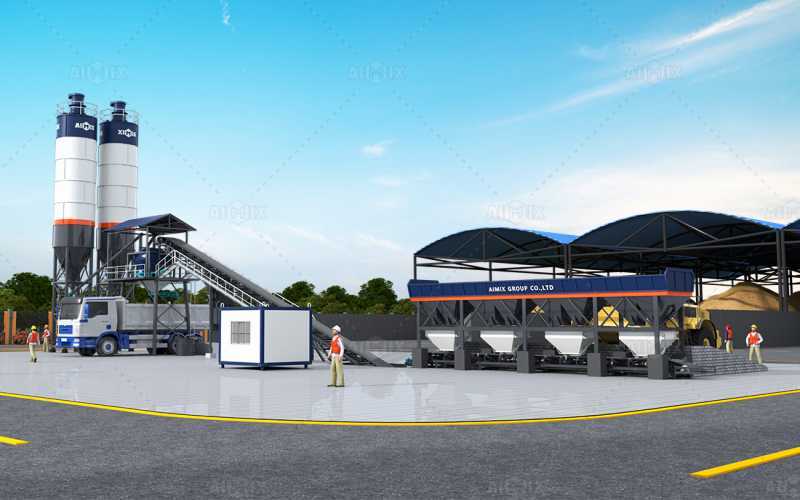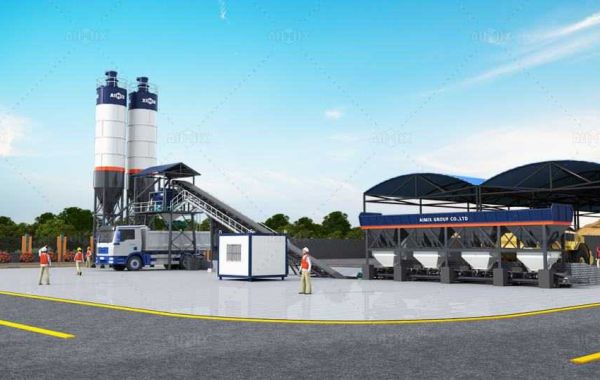In the fast-paced world of construction, efficiency and safety are paramount. Modern dry batch concrete plants play a crucial role in ensuring timely and reliable concrete production for projects of all sizes. However, as with any large industrial machinery, dry batch plants present certain risks that, if not properly managed, can lead to accidents, equipment damage, or even fatalities. To address these concerns, manufacturers have developed a range of advanced safety features designed to minimize operational risks while maximizing plant efficiency.
This article explores the most important safety features in modern dry batch concrete plants and how they contribute to safer, more reliable operations.

Automated Control Systems
Automation has become a fundamental component in modern dry batch plants, not only improving operational efficiency but also enhancing safety. Automated control systems help manage the batching process with minimal human intervention, reducing the risk of operator error, which is a common cause of accidents.
These systems regulate the precise mixing of aggregates, cement, and water, ensuring that the right quantities are combined safely. Moreover, automated control panels often include emergency shutdown protocols and safety interlocks that automatically stop operations if any malfunction or safety hazard is detected. This not only prevents accidents but also protects the integrity of the batching process, ensuring that only quality concrete is produced.
Automation also allows operators to monitor the plant remotely, reducing the need for personnel to be physically present near potentially hazardous machinery. With real-time data on plant operations, potential risks can be identified and addressed before they lead to unsafe conditions.
Dust Collection and Filtration Systems
One of the major safety hazards in dry batch plants is airborne dust, which can cause respiratory issues for workers and increase the risk of fire or explosion. Cement dust, in particular, is hazardous if inhaled in large quantities over time, and dust particles can also create a combustible environment if they accumulate in certain areas.
Modern dry batch plants are equipped with dust collection and filtration systems to mitigate this risk. These systems capture dust at the source, such as during the loading of cement and aggregates, and filter it before it can escape into the environment. The captured dust is often recycled back into the production process, reducing waste and improving plant sustainability.
By preventing the spread of dust, these systems contribute to a safer working environment, particularly in enclosed plant areas. Moreover, the use of dust collection systems ensures compliance with environmental regulations, further safeguarding the plant against operational shutdowns or fines due to non-compliance.
Overload Protection Systems
Overload protection is a critical safety feature in dry batch concrete plants, especially when handling large quantities of aggregates and cement. Modern plants are equipped with overload sensors that monitor the weight of materials being loaded into the system. If the sensors detect an overload condition, the system automatically halts operations to prevent damage to the plant’s components or accidents caused by the equipment being overburdened.
In addition to protecting the machinery from excessive loads, these systems ensure that operators are aware of any potential issues, allowing them to take corrective action before continuing with the batching process. This level of control reduces the risk of equipment failure, which can lead to dangerous situations such as material spills or machinery breakdowns. If you would like to know more about different types of concrete plants and other information, you can click to open this page https://aimixgroup.com/concrete-batching-plant/.

Fail-Safe Mechanisms and Backup Systems
Modern dry batch plants are designed with fail-safe mechanisms to ensure that, even in the event of a power failure or equipment malfunction, the plant can be safely shut down. These mechanisms include backup power systems, manual overrides, and emergency stop buttons, all of which are crucial for maintaining control in unexpected situations.
For example, backup power systems allow critical safety functions to remain operational even if the main power supply is interrupted. This ensures that the plant can be shut down safely, reducing the risk of accidents due to uncontrolled equipment movements or material spills.
Manual overrides allow operators to regain control of the batching process in case the automated systems fail, while emergency stop buttons are strategically located throughout the plant, giving workers the ability to instantly halt operations if they notice any unsafe conditions.
Enhanced Operator Training and Safety Protocols
While advanced safety features significantly reduce the risks associated with dry batch plant operations, human error remains a leading cause of accidents. Therefore, modern plants place a strong emphasis on operator training and safety protocols.
Many manufacturers provide comprehensive training programs to ensure that plant operators are well-versed in both the operation of the equipment and the safety procedures specific to the plant. This includes training on how to properly use safety equipment, respond to emergency situations, and follow best practices for avoiding accidents.
In addition to training, dry batch plants often implement strict safety protocols, such as lockout/tagout (LOTO) procedures, which ensure that machinery is properly shut down and secured before maintenance or repairs are carried out. These protocols help prevent accidental machine startups, which can cause serious injuries to maintenance personnel.
Real-Time Monitoring and Diagnostics
Many modern dry batch plants are equipped with real-time monitoring and diagnostics systems that provide operators with continuous feedback on plant performance. These systems track key metrics such as load levels, motor performance, and system temperatures, allowing operators to identify potential issues before they escalate into serious problems.
For example, if the monitoring system detects that a motor is overheating, it can alert the operator to shut down the plant and investigate the cause, preventing further damage or accidents. Real-time diagnostics also help with predictive maintenance, allowing plant managers to address wear and tear before equipment failure occurs.
Remote Operation and Surveillance
Modern batching plants can often be operated remotely, allowing for enhanced safety and oversight. With the help of surveillance cameras, sensors, and control panels, operators can monitor and control batching processes from a safe distance. This reduces the need for workers to be close to potentially hazardous machinery, lowering the risk of injury.
Safety is a paramount concern in any industrial operation, and dry batch concrete plants are no exception. Manufacturers have risen to the challenge by integrating advanced safety features, such as automated control systems, dust collection technologies, overload protection, fail-safe mechanisms, and real-time monitoring. These innovations not only reduce the risk of accidents but also improve the overall efficiency and reliability of batching operations.
By prioritizing safety in both design and operation, modern dry batch plants offer a safer working environment for operators while maintaining high levels of productivity. As the construction industry continues to grow, these advanced safety features will play an increasingly important role in protecting workers and ensuring the smooth operation of concrete production facilities.








